Gepubliceerd op woensdag 20 mei 2015
Driehoekig oppervlak met zwarte stippen geen vormmerk
|
|
65 In those circumstances, the signs at issue not having any clear ornamental character, their registration would improperly reduce the possibilities for competitors to bring to the market alternative product shapes incorporating the same non-skid technical solution. In that regard, it should be observed that the case-law states that, under Article 9(1) of Regulation No 207/2009, registration as a trade mark of a purely functional product shape is likely to allow the proprietor of that trade mark to prevent other undertakings not only from using the same shape, but also from using similar shapes. A significant number of alternative shapes might therefore become unusable for the proprietor’s competitors. That would be particularly so if various purely functional shapes of goods were registered at the same time, which might completely prevent other undertakings from manufacturing and marketing certain goods having a particular technical function (see, to that effect, judgment in Lego Juris v OHIM, cited in paragraph 60 above, EU:C:2010:516, paragraphs 56 and 57).66 Having regard to the findings in paragraphs 59 to 65 above, the Board of Appeal committed no error in concluding, in paragraph 42 of the contested decisions, that the registrations of the marks at issue had to be declared invalid, pursuant to Article 7(1)(e)(ii), in so far as the essential characteristics of the signs at issue consisted exclusively of the shape of goods necessary to obtain a technical result.



























































































